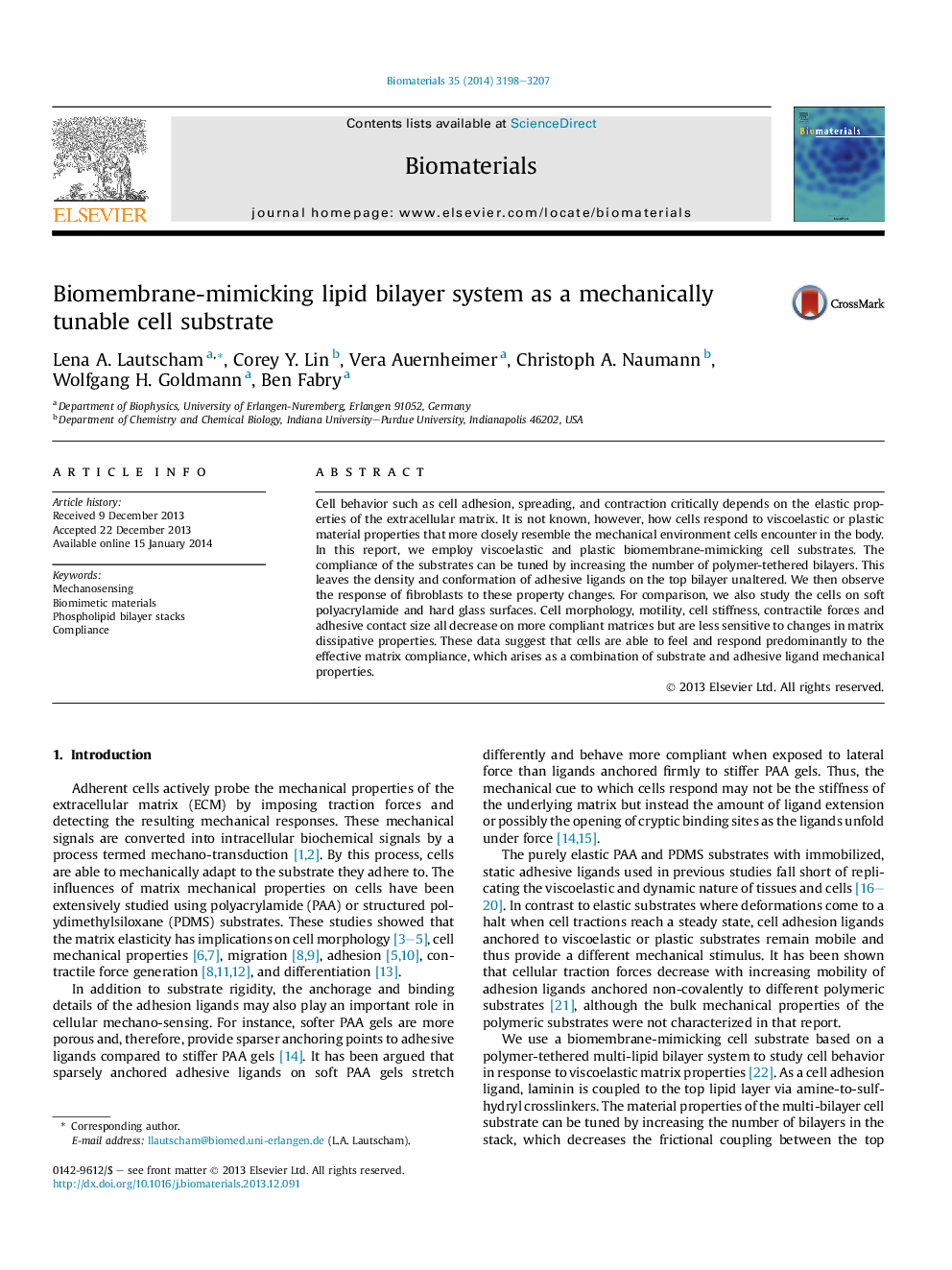| کد مقاله | کد نشریه | سال انتشار | مقاله انگلیسی | نسخه تمام متن |
|---|---|---|---|---|
| 10227921 | 469 | 2014 | 10 صفحه PDF | دانلود رایگان |
عنوان انگلیسی مقاله ISI
Biomembrane-mimicking lipid bilayer system as a mechanically tunable cell substrate
ترجمه فارسی عنوان
سیستم بیولوژیکی لیپید بیومسرومیک به عنوان یک سوبسترای سلولی قابل تنظیم مکانیکی
دانلود مقاله + سفارش ترجمه
دانلود مقاله ISI انگلیسی
رایگان برای ایرانیان
کلمات کلیدی
مکانیسنسینگ، مواد بیومیدانه، پشته دو لایه فسفولیپید، انطباق،
ترجمه چکیده
رفتار سلولی مانند چسبندگی سلول، گسترش و انقباض به طور واضح بستگی به خواص الاستیک ماتریس خارج سلولی دارد. با این حال مشخص نیست که چگونه سلولها به خواص مواد ویسکوالاستیک یا پلاستیک پاسخ می دهند که بیشتر شبیه سلول های مکانیکی محیط بدن هستند. در این گزارش، ما با استفاده از بسترهای سلولی و بیرونی پلاستیک و ویسکوزیته و پلاستیک می توانیم استفاده کنیم. انطباق زیربناها را می توان با افزایش تعداد دو لایه پلیمر تسمه ای تنظیم کرد. این چگالی و سازگاری لیگاندهای چسب را در دو لایه بالا بدون تغییر حفظ می کند. سپس پاسخ فیبروبلاست ها را به این تغییرات دارایی مشاهده می کنیم. برای مقایسه، ما همچنین سلول ها را روی پلی آکریل آمید نرم و سطوح سخت شیشه مطالعه می کنیم. مورفولوژی سلول، حرکتی، سختی سلول، نیروهای انقباضی و اندازه تماس مخاطب بر روی ماتریسهای سازگار کمتر، اما کمتر به تغییرات خواص بازدارنده ماتریس حساس هستند. این داده ها نشان می دهد که سلول ها قادر به احساس رضایت و پاسخ بیشتر به رعایت ماتریس موثر هستند که به عنوان ترکیبی از خواص مکانیکی لیگاند و بستر و چسبندگی ایجاد می شود.
موضوعات مرتبط
مهندسی و علوم پایه
مهندسی شیمی
بیو مهندسی (مهندسی زیستی)
چکیده انگلیسی
Cell behavior such as cell adhesion, spreading, and contraction critically depends on the elastic properties of the extracellular matrix. It is not known, however, how cells respond to viscoelastic or plastic material properties that more closely resemble the mechanical environment cells encounter in the body. In this report, we employ viscoelastic and plastic biomembrane-mimicking cell substrates. The compliance of the substrates can be tuned by increasing the number of polymer-tethered bilayers. This leaves the density and conformation of adhesive ligands on the top bilayer unaltered. We then observe the response of fibroblasts to these property changes. For comparison, we also study the cells on soft polyacrylamide and hard glass surfaces. Cell morphology, motility, cell stiffness, contractile forces and adhesive contact size all decrease on more compliant matrices but are less sensitive to changes in matrix dissipative properties. These data suggest that cells are able to feel and respond predominantly to the effective matrix compliance, which arises as a combination of substrate and adhesive ligand mechanical properties.
ناشر
Database: Elsevier - ScienceDirect (ساینس دایرکت)
Journal: Biomaterials - Volume 35, Issue 10, March 2014, Pages 3198-3207
Journal: Biomaterials - Volume 35, Issue 10, March 2014, Pages 3198-3207
نویسندگان
Lena A. Lautscham, Corey Y. Lin, Vera Auernheimer, Christoph A. Naumann, Wolfgang H. Goldmann, Ben Fabry,
